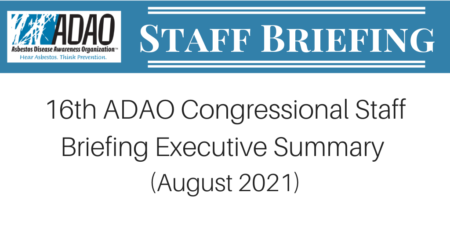16th ADAO Congressional Staff Briefing (August 18, 2021)
“Impact of Asbestos on Public Health, Environment, and Economy”
Briefing Flyer
Briefing Press Release
Staffer Briefing Resource Page
Briefing Executive Summary
Briefing Presenter Biographies
Briefing Blog
Briefing Recorded Video
Briefing PowerPoint
Executive Summary (August 2021)
Brad Black, MD, Libby, Montana
- The vermiculite from the Libby mine was contaminated with a toxic and highly friable form of asbestos called tremolite-actinolite series asbestos, often called Libby Amphibole asbestos (LA).
- At least 400 deaths have been documented, but health officials suspect the number is higher. And more than 2,400 people have been diagnosed with asbestos-related disease after being screened at the Center for Asbestos Related Disease (CARD) clinic in Libby.
Barry Castleman, ScD, Environmental Consultant
- Asbestos exposure causes mesothelioma, lung, ovarian and laryngeal cancer, asbestosis and other pleural diseases.
- In 2020, an estimated 300 metric tons of raw asbestos was imported from Russia and Brazil for the chlor-alkali industry, the sole user of raw asbestos.
Raja Flores, MD, Chair of the Department of Thoracic Surgery, Mount Sinai School of Medicine
- Members of Congress can do more with a pen than I can with a scalpel.
- World Trade Center Health Program Facts:
- 70,000 workers have chronic conditions
- 10-15 new cancers a week
Arthur L. Frank, MD, PhD, Professor of Public Health and Chair Emeritus of the Department of Environmental and Occupational Health at the Drexel University School of Public Health in Philadelphia
- The Asbestos Hazard Emergency Response Act (AHERA) (Toxic Substances Control Act (TSCA) Title II) “defines asbestos as the asbestiform varieties of: chrysotile (serpentine); crocidolite (riebeckite); amosite (cummingtonite/grunerite); anthophyllite; tremolite; and actinolite.” and is what is considered by scientists around the world to be “asbestos”.
- There is no safe level of exposure to asbestos (actinolite, anthophyllite, amosite, chrysotile, crocidolite, and tremolite), a known carcinogen, and it becomes dangerous when the microscopic asbestos fibers become dislodged and airborne.
Brent Kynoch, Managing Director, Environmental Information Association
- Nearly 70 countries have banned asbestos. Sadly, the US is not among these forward thinking nations.
- Legacy asbestos still resides in homes, schools, workplaces, and the environment. Without a ban, the “legacy” of exposure, disease and death will continue unabated.
Richard Lemen, PhD, MSPH, Retired Assistant Surgeon General of the United States:
- In 1976, the National Institute for Occupational Safety and Health (NIOSH) was the first US federal agency to recommend a ban on asbestos in the workplace.
- There can be no doubt of a causal relationship between asbestos exposure and a subsequent increased risk of asbestos-related diseases.
Celeste Monforton, DrPH, MPH, American Public Health Association
- In 2009 and again in 2019, APHA issued a policy statement urging Congress to ban asbestos
- 2019 ARBAN was supported by 19 state attorneys general, the AFL-CIO, Int’l Association of Fire Fighters, NRDC, Union of Concerned Scientists, EWG, Beautycounter, and many other organizations.
Linda Reinstein, Asbestos Disease Awareness Organization
- Each year, over 40,000 Americans die from preventable asbestos-caused diseases.
- The Alan Reinstein Ban Asbestos Now (ARBAN) Act of 2019 was voted out of the House Committee on Energy and Commerce (E&C) with a strong bipartisan margin of 47-1 on November 19, 2019.
Greg Russell, Government Relations for the International Association of Fire Fighters
-
- According to the NIOSH Firefighter study, “Fire fighters have a rate of mesothelioma two times greater than the rate in the U.S. population as a whole.”
- When asbestos becomes airborne when disturbed or damaged by fire, fire fighters can inhale large amounts of these microscopic fibers, increasing their risk of developing an asbestos-related disease such as mesothelioma, lung cancer and asbestosis.
Bob Sussman, Former EPA Deputy Administrator and Senior Policy Counsel to the EPA Administrator
- After conducting a disappointing and flawed risk evaluation on asbestos under TSCA, EPA is using its risk management authority to restrict the small number of ongoing asbestos uses identified in the evaluation. This process will take several years; may not result in a complete asbestos ban; and could be tied up in litigation. These are compelling reasons why we cannot count on the EPA to ban asbestos and Congress must, itself, get the job done. ARBAN would do exactly that.
- EPA has also been directed by a court of appeals to expand its risk evaluation to address legacy asbestos. But EPA is only at the beginning stages of this complex task and it will be years before the Agency has made findings about the risks to health from the asbestos contained in tens of thousands of structures in the US. ARBAN would jumpstart this effort by directing the National Academy of Sciences (NAS) to conduct a comprehensive study of risks presented by “legacy” asbestos.

